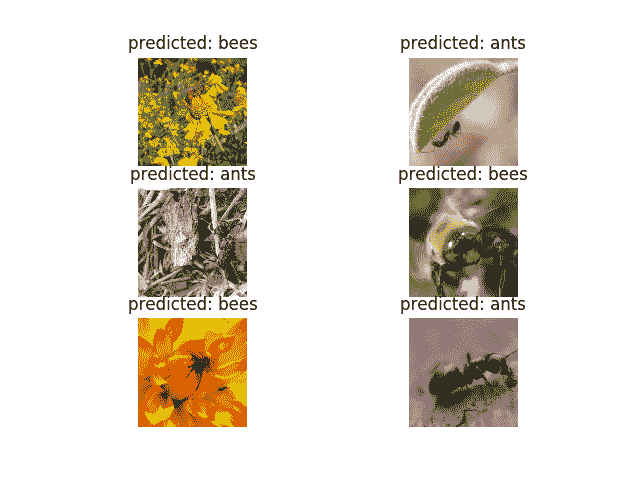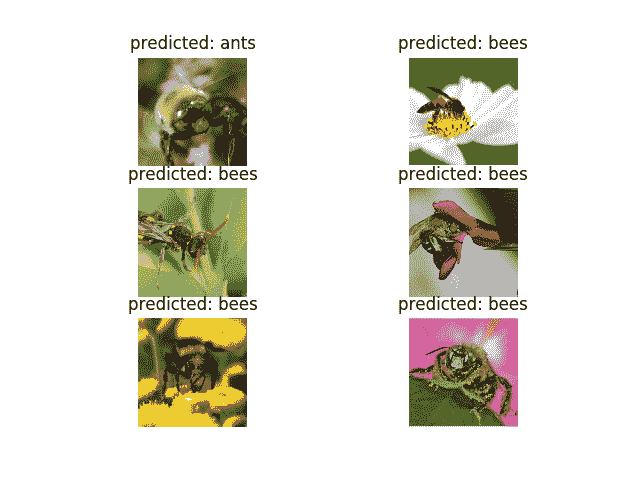计算机视觉的迁移学习教程
原文:https://pytorch.org/tutorials/beginner/transfer_learning_tutorial.html
在本教程中,您将学习如何使用迁移学习训练卷积神经网络进行图像分类。 您可以在 cs231n 笔记中阅读有关转学的更多信息。
引用这些注解,
实际上,很少有人从头开始训练整个卷积网络(使用随机初始化),因为拥有足够大小的数据集相对很少。 相反,通常在非常大的数据集上对 ConvNet 进行预训练(例如 ImageNet,其中包含 120 万个具有 1000 个类别的图像),然后将 ConvNet 用作初始化或固定特征提取器以完成感兴趣的任务。
这两个主要的迁移学习方案如下所示:
- 卷积网络的微调:代替随机初始化,我们使用经过预训练的网络初始化网络,例如在 imagenet 1000 数据集上进行训练的网络。 其余的训练照常进行。
- 作为固定特征提取器的 ConvNet:在这里,我们将冻结除最终全连接层之外的所有网络的权重。 最后一个全连接层将替换为具有随机权重的新层,并且仅训练该层。
# License: BSD
# Author: Sasank Chilamkurthy
from __future__ import print_function, division
import torch
import torch.nn as nn
import torch.optim as optim
from torch.optim import lr_scheduler
import numpy as np
import torchvision
from torchvision import datasets, models, transforms
import matplotlib.pyplot as plt
import time
import os
import copy
plt.ion() # interactive mode
加载数据
我们将使用torchvision和torch.utils.data包来加载数据。
我们今天要解决的问题是训练一个模型来对蚂蚁和蜜蜂进行分类。 我们为蚂蚁和蜜蜂提供了大约 120 张训练图像。 每个类别有 75 个验证图像。 通常,如果从头开始训练的话,这是一个非常小的数据集。 由于我们正在使用迁移学习,因此我们应该能够很好地概括。
该数据集是 imagenet 的很小一部分。
注意
从的下载数据,并将其提取到当前目录。
# Data augmentation and normalization for training
# Just normalization for validation
data_transforms = {
'train': transforms.Compose([
transforms.RandomResizedCrop(224),
transforms.RandomHorizontalFlip(),
transforms.ToTensor(),
transforms.Normalize([0.485, 0.456, 0.406], [0.229, 0.224, 0.225])
]),
'val': transforms.Compose([
transforms.Resize(256),
transforms.CenterCrop(224),
transforms.ToTensor(),
transforms.Normalize([0.485, 0.456, 0.406], [0.229, 0.224, 0.225])
]),
}
data_dir = 'data/hymenoptera_data'
image_datasets = {x: datasets.ImageFolder(os.path.join(data_dir, x),
data_transforms[x])
for x in ['train', 'val']}
dataloaders = {x: torch.utils.data.DataLoader(image_datasets[x], batch_size=4,
shuffle=True, num_workers=4)
for x in ['train', 'val']}
dataset_sizes = {x: len(image_datasets[x]) for x in ['train', 'val']}
class_names = image_datasets['train'].classes
device = torch.device("cuda:0" if torch.cuda.is_available() else "cpu")
可视化一些图像
让我们可视化一些训练图像,以了解数据扩充。
def imshow(inp, title=None):
"""Imshow for Tensor."""
inp = inp.numpy().transpose((1, 2, 0))
mean = np.array([0.485, 0.456, 0.406])
std = np.array([0.229, 0.224, 0.225])
inp = std * inp + mean
inp = np.clip(inp, 0, 1)
plt.imshow(inp)
if title is not None:
plt.title(title)
plt.pause(0.001) # pause a bit so that plots are updated
# Get a batch of training data
inputs, classes = next(iter(dataloaders['train']))
# Make a grid from batch
out = torchvision.utils.make_grid(inputs)
imshow(out, title=[class_names[x] for x in classes])

训练模型
现在,让我们编写一个通用函数来训练模型。 在这里,我们将说明:
- 安排学习率
- 保存最佳模型
以下,参数scheduler是来自torch.optim.lr_scheduler的 LR 调度器对象。
def train_model(model, criterion, optimizer, scheduler, num_epochs=25):
since = time.time()
best_model_wts = copy.deepcopy(model.state_dict())
best_acc = 0.0
for epoch in range(num_epochs):
print('Epoch {}/{}'.format(epoch, num_epochs - 1))
print('-' * 10)
# Each epoch has a training and validation phase
for phase in ['train', 'val']:
if phase == 'train':
model.train() # Set model to training mode
else:
model.eval() # Set model to evaluate mode
running_loss = 0.0
running_corrects = 0
# Iterate over data.
for inputs, labels in dataloaders[phase]:
inputs = inputs.to(device)
labels = labels.to(device)
# zero the parameter gradients
optimizer.zero_grad()
# forward
# track history if only in train
with torch.set_grad_enabled(phase == 'train'):
outputs = model(inputs)
_, preds = torch.max(outputs, 1)
loss = criterion(outputs, labels)
# backward + optimize only if in training phase
if phase == 'train':
loss.backward()
optimizer.step()
# statistics
running_loss += loss.item() * inputs.size(0)
running_corrects += torch.sum(preds == labels.data)
if phase == 'train':
scheduler.step()
epoch_loss = running_loss / dataset_sizes[phase]
epoch_acc = running_corrects.double() / dataset_sizes[phase]
print('{} Loss: {:.4f} Acc: {:.4f}'.format(
phase, epoch_loss, epoch_acc))
# deep copy the model
if phase == 'val' and epoch_acc > best_acc:
best_acc = epoch_acc
best_model_wts = copy.deepcopy(model.state_dict())
print()
time_elapsed = time.time() - since
print('Training complete in {:.0f}m {:.0f}s'.format(
time_elapsed // 60, time_elapsed % 60))
print('Best val Acc: {:4f}'.format(best_acc))
# load best model weights
model.load_state_dict(best_model_wts)
return model
可视化模型预测
通用函数,显示一些图像的预测
def visualize_model(model, num_images=6):
was_training = model.training
model.eval()
images_so_far = 0
fig = plt.figure()
with torch.no_grad():
for i, (inputs, labels) in enumerate(dataloaders['val']):
inputs = inputs.to(device)
labels = labels.to(device)
outputs = model(inputs)
_, preds = torch.max(outputs, 1)
for j in range(inputs.size()[0]):
images_so_far += 1
ax = plt.subplot(num_images//2, 2, images_so_far)
ax.axis('off')
ax.set_title(f'predicted: {class_names[preds[j]]}')
imshow(inputs.cpu().data[j])
if images_so_far == num_images:
model.train(mode=was_training)
return
model.train(mode=was_training)
微调 ConvNet
加载预训练的模型并重置最终的全连接层。
model_ft = models.resnet18(pretrained=True)
num_ftrs = model_ft.fc.in_features
# Here the size of each output sample is set to 2.
# Alternatively, it can be generalized to nn.Linear(num_ftrs, len(class_names)).
model_ft.fc = nn.Linear(num_ftrs, 2)
model_ft = model_ft.to(device)
criterion = nn.CrossEntropyLoss()
# Observe that all parameters are being optimized
optimizer_ft = optim.SGD(model_ft.parameters(), lr=0.001, momentum=0.9)
# Decay LR by a factor of 0.1 every 7 epochs
exp_lr_scheduler = lr_scheduler.StepLR(optimizer_ft, step_size=7, gamma=0.1)
训练和评估
在 CPU 上大约需要 15-25 分钟。 但是在 GPU 上,此过程不到一分钟。
model_ft = train_model(model_ft, criterion, optimizer_ft, exp_lr_scheduler,
num_epochs=25)
出:
Epoch 0/24
----------
train Loss: 0.6303 Acc: 0.6926
val Loss: 0.1492 Acc: 0.9346
Epoch 1/24
----------
train Loss: 0.5511 Acc: 0.7869
val Loss: 0.2577 Acc: 0.8889
Epoch 2/24
----------
train Loss: 0.4885 Acc: 0.8115
val Loss: 0.3390 Acc: 0.8758
Epoch 3/24
----------
train Loss: 0.5158 Acc: 0.7992
val Loss: 0.5070 Acc: 0.8366
Epoch 4/24
----------
train Loss: 0.5878 Acc: 0.7992
val Loss: 0.2706 Acc: 0.8758
Epoch 5/24
----------
train Loss: 0.4396 Acc: 0.8279
val Loss: 0.2870 Acc: 0.8954
Epoch 6/24
----------
train Loss: 0.4612 Acc: 0.8238
val Loss: 0.2809 Acc: 0.9150
Epoch 7/24
----------
train Loss: 0.4387 Acc: 0.8402
val Loss: 0.1853 Acc: 0.9281
Epoch 8/24
----------
train Loss: 0.2998 Acc: 0.8648
val Loss: 0.1926 Acc: 0.9085
Epoch 9/24
----------
train Loss: 0.3383 Acc: 0.9016
val Loss: 0.1762 Acc: 0.9281
Epoch 10/24
----------
train Loss: 0.2969 Acc: 0.8730
val Loss: 0.1872 Acc: 0.8954
Epoch 11/24
----------
train Loss: 0.3117 Acc: 0.8811
val Loss: 0.1807 Acc: 0.9150
Epoch 12/24
----------
train Loss: 0.3005 Acc: 0.8770
val Loss: 0.1930 Acc: 0.9085
Epoch 13/24
----------
train Loss: 0.3129 Acc: 0.8689
val Loss: 0.2184 Acc: 0.9150
Epoch 14/24
----------
train Loss: 0.3776 Acc: 0.8607
val Loss: 0.1869 Acc: 0.9216
Epoch 15/24
----------
train Loss: 0.2245 Acc: 0.9016
val Loss: 0.1742 Acc: 0.9346
Epoch 16/24
----------
train Loss: 0.3105 Acc: 0.8607
val Loss: 0.2056 Acc: 0.9216
Epoch 17/24
----------
train Loss: 0.2729 Acc: 0.8893
val Loss: 0.1722 Acc: 0.9085
Epoch 18/24
----------
train Loss: 0.3210 Acc: 0.8730
val Loss: 0.1977 Acc: 0.9281
Epoch 19/24
----------
train Loss: 0.3231 Acc: 0.8566
val Loss: 0.1811 Acc: 0.9216
Epoch 20/24
----------
train Loss: 0.3206 Acc: 0.8648
val Loss: 0.2033 Acc: 0.9150
Epoch 21/24
----------
train Loss: 0.2917 Acc: 0.8648
val Loss: 0.1694 Acc: 0.9150
Epoch 22/24
----------
train Loss: 0.2412 Acc: 0.8852
val Loss: 0.1757 Acc: 0.9216
Epoch 23/24
----------
train Loss: 0.2508 Acc: 0.8975
val Loss: 0.1662 Acc: 0.9281
Epoch 24/24
----------
train Loss: 0.3283 Acc: 0.8566
val Loss: 0.1761 Acc: 0.9281
Training complete in 1m 10s
Best val Acc: 0.934641
visualize_model(model_ft)

作为固定特征提取器的 ConvNet
在这里,我们需要冻结除最后一层之外的所有网络。 我们需要设置requires_grad == False冻结参数,以便不在backward()中计算梯度。
model_conv = torchvision.models.resnet18(pretrained=True)
for param in model_conv.parameters():
param.requires_grad = False
# Parameters of newly constructed modules have requires_grad=True by default
num_ftrs = model_conv.fc.in_features
model_conv.fc = nn.Linear(num_ftrs, 2)
model_conv = model_conv.to(device)
criterion = nn.CrossEntropyLoss()
# Observe that only parameters of final layer are being optimized as
# opposed to before.
optimizer_conv = optim.SGD(model_conv.fc.parameters(), lr=0.001, momentum=0.9)
# Decay LR by a factor of 0.1 every 7 epochs
exp_lr_scheduler = lr_scheduler.StepLR(optimizer_conv, step_size=7, gamma=0.1)
训练和评估
与以前的方案相比,在 CPU 上将花费大约一半的时间。 这是可以预期的,因为不需要为大多数网络计算梯度。 但是,确实需要计算正向。
model_conv = train_model(model_conv, criterion, optimizer_conv,
exp_lr_scheduler, num_epochs=25)
出:
Epoch 0/24
----------
train Loss: 0.7258 Acc: 0.6148
val Loss: 0.2690 Acc: 0.9020
Epoch 1/24
----------
train Loss: 0.5342 Acc: 0.7500
val Loss: 0.1905 Acc: 0.9412
Epoch 2/24
----------
train Loss: 0.4262 Acc: 0.8320
val Loss: 0.1903 Acc: 0.9412
Epoch 3/24
----------
train Loss: 0.4103 Acc: 0.8197
val Loss: 0.2658 Acc: 0.8954
Epoch 4/24
----------
train Loss: 0.3938 Acc: 0.8115
val Loss: 0.2871 Acc: 0.8954
Epoch 5/24
----------
train Loss: 0.4623 Acc: 0.8361
val Loss: 0.1651 Acc: 0.9346
Epoch 6/24
----------
train Loss: 0.5348 Acc: 0.7869
val Loss: 0.1944 Acc: 0.9477
Epoch 7/24
----------
train Loss: 0.3827 Acc: 0.8402
val Loss: 0.1846 Acc: 0.9412
Epoch 8/24
----------
train Loss: 0.3655 Acc: 0.8443
val Loss: 0.1873 Acc: 0.9412
Epoch 9/24
----------
train Loss: 0.3275 Acc: 0.8525
val Loss: 0.2091 Acc: 0.9412
Epoch 10/24
----------
train Loss: 0.3375 Acc: 0.8320
val Loss: 0.1798 Acc: 0.9412
Epoch 11/24
----------
train Loss: 0.3077 Acc: 0.8648
val Loss: 0.1942 Acc: 0.9346
Epoch 12/24
----------
train Loss: 0.4336 Acc: 0.7787
val Loss: 0.1934 Acc: 0.9346
Epoch 13/24
----------
train Loss: 0.3149 Acc: 0.8566
val Loss: 0.2062 Acc: 0.9281
Epoch 14/24
----------
train Loss: 0.3617 Acc: 0.8320
val Loss: 0.1761 Acc: 0.9412
Epoch 15/24
----------
train Loss: 0.3066 Acc: 0.8361
val Loss: 0.1799 Acc: 0.9281
Epoch 16/24
----------
train Loss: 0.3952 Acc: 0.8443
val Loss: 0.1666 Acc: 0.9346
Epoch 17/24
----------
train Loss: 0.3552 Acc: 0.8443
val Loss: 0.1928 Acc: 0.9412
Epoch 18/24
----------
train Loss: 0.3106 Acc: 0.8648
val Loss: 0.1964 Acc: 0.9346
Epoch 19/24
----------
train Loss: 0.3675 Acc: 0.8566
val Loss: 0.1813 Acc: 0.9346
Epoch 20/24
----------
train Loss: 0.3565 Acc: 0.8320
val Loss: 0.1758 Acc: 0.9346
Epoch 21/24
----------
train Loss: 0.2922 Acc: 0.8566
val Loss: 0.2295 Acc: 0.9216
Epoch 22/24
----------
train Loss: 0.3283 Acc: 0.8402
val Loss: 0.2267 Acc: 0.9281
Epoch 23/24
----------
train Loss: 0.2875 Acc: 0.8770
val Loss: 0.1878 Acc: 0.9346
Epoch 24/24
----------
train Loss: 0.3172 Acc: 0.8689
val Loss: 0.1849 Acc: 0.9412
Training complete in 0m 34s
Best val Acc: 0.947712
visualize_model(model_conv)
plt.ioff()
plt.show()

进一步学习
如果您想了解有关迁移学习的更多信息,请查看我们的计算机视觉教程的量化迁移学习。
脚本的总运行时间:(1 分钟 56.157 秒)
下载 Python 源码:transfer_learning_tutorial.py
下载 Jupyter 笔记本:transfer_learning_tutorial.ipynb
由 Sphinx 画廊生成的画廊